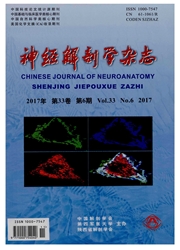

 中文摘要:
中文摘要:
目的:为研究脊髓电刺激(spinal cord stimulation,SCS)镇痛作用的机制提供方便、实用和有效的sD大鼠脊髓硬膜外双电极刺激模型。方法:选取250~350g雄性sD大鼠,结扎其左侧L5脊神经制作神经病理性痛模型。在此基础上,将制作的电极置入脊髓背侧硬膜外间隙(T11—T12),电极尾端经皮下隧道从颈后部引出、并固定于皮肤。术后恢复5d,行脊髓电刺激测试。用电子VonFrey测试仪测量建模前后大鼠后肢的机械性缩足阈值,评估硬膜外双电极刺激对其术侧后肢机械性缩足阈值的影响。SCS测试后第2d,在大鼠腹腔内注射大麻素1型受体(CBl)的拮抗剂AM251,然后观察Abl251对大鼠SCS镇痛作用的影响。结果:大鼠左侧后肢机械性缩足的基础阈值为49.37±6.99g,【5脊神经结扎及硬膜外电极置入术后机械性缩足的阈值为19.23±5.12g,行SCS(20I-Iz,150—200mV)30min后术侧机械性缩足阈值为35.62g±7.27g,与给予SCS刺激前比较具有显著性差异(P〈0.01);而与手术对侧(右侧)相比,机械性缩足阈值无明显变化(P〉0.05)。腹腔注射AM251可翻转SCS的镇痛作用(15.00±1.01g,P〈0.01)。结论:硬膜外双电极植入方法取材容易,简单易行,与当前临床普遍应用的电刺激装置极为相似,为进一步研究脊髓电刺激的镇痛机理提供了可靠的模型,并为其他领域脊髓硬膜外电刺激实验动物模型的制作提供了参考。本文结果还提示内源性大麻素CBl受体可能参与SCS的镇痛机制。
 英文摘要:
英文摘要:
Objective: To provide simple and useful rat model of epidural spinal cord stimulation with bipolar electrodes for the study of analgestic mechanism of spinal cord stimulation (SCS). Methods: Male SD rats weighting 250 - 350 g were used. The left I_5 spinal nerve was ligated to create a rat-neuropathic-pain model. Then, the electrodes were put in the space of the epidural at Tll-T12 level. The tail of the electrodes was fixed at the rats' nape. SCS test began after 5 days recovery. Electro-Von Frey test was used to measure the mechanical withdraw threshold (MWT) to estimate epidural SCS effect of the hind paw after spinal nerve ligation (SNL). Two days after SCS test, AM251, the cannabinoid receptor 1 (CB1)antagonist, was injected intraperitoneally to observe the influence of AM251 on the analgesic effect of SCS. Results : The base line of the MWT in ipsilateral paw was 49.37 ± 6.99 g. After ligation of the left L5 nerve root and planta- tion of the electrodes, the MWT was 19.23 ± 5.12 g, SCS for 30 min (20 Hz, 150 - 200 mV) significantly reversed the MWT to 35.62 ± 7.27 g ( P 〈 0.01 ). The MWT had no significant changes in contralateral hind paw ( P 〉 0.05). Intraperitoneal injection of AM251 could reverse the analgesic effect induced by SCS( 15.00 ± 1.01 g,P 〈0.01 ). Conclusion: This study introduced a simple and useful bipolar-animal-SCS model. The materials for making the electrode are easy to obtain. The bipolar-epidural implants we used are resembled with those currently used in the clinic. This mode! is applicable to study the mechanism of SCS, in both pain and other related research fields. Furthermore, the present study also suggests that the endocannabinoid CB1 receptors may be involved in the SCS induced analgesia.
 同期刊论文项目
同期刊论文项目
 同项目期刊论文
同项目期刊论文
 期刊信息
期刊信息
